- You can quickly search meaning or reading of the kanji using handwriting recognition.
- You can easily notice differences on the kanji figure after learning of stroke order.
- Kanji, 漢字, 日本における漢字
- Calligraphy/書道
Kanji is drown by a ink bursh.
毛筆を用いて書き、濃淡、肥痩、緩急の筆使いが審美の対象となる。
- Mu
in English is more famously used as a response to certain koans
and other questions in Zen Buddhism.
mu - 無 - null
画と画の間の連続性を表現する空筆(Null Stroke)は、 「無」、 「禅」、 「枯山水」などの文化に通じる。 - There are different stroke orders to CJK (Chinese, Japanese or Korean).
中国語、韓国語、日本語で、筆順が異なる漢字がある。 - 昭和33年(1958年)、『筆順指導の手びき』が文部省から出され、それに準拠して教育が行われている。
ただし、「本書に取りあげなかった筆順についても,これを誤りとするものでもない。」と記述されている。
- →: Left to right / 左から右へ
右手で書くとき、書いた文字が隠れない。
一, 二, 三, - ↓: Up to down / 上から下に
上から下に漢字を書くと、書いた文字が隠れない。
川, 十, 上, 中 - →↓: Left to right and up to down (no null stroke) /
左から右へ、連続で、上から下に(¬)
口, 日 - ↓→: Up to down and left to right (no null stroke) /
上から下に、連続で、左から右へ
山, 区, 断
- Stop Stroke:止め(2nd stroke in the following figure)
- Sweep Stroke:はらう(3rd stroke in the following figure)
- Hook Stroke:はねる(1st stroke in the following figure)
- Null Stroke:空筆(between 1st stroke and 2nd stroke in the following figure)
小学1年生の書いた書道の一部”け”
Use this page after printing. / このページを印刷して、利用してください。
Noticing method using
kanji handwriting recognition /
手書き漢字認識を利用した「気づき」の活用
Check "x" mark. Don't forget that direction of stroke is important.
Check "x" mark.
Check "x" mark.
Check "x" mark.
Check "x" mark.
No. Rules Kanji 1st
From top to bottom
上の部分から下の部分へ書いていく。
二(2, two)


三(3, three)


工(craft, construction)


王(king, rule)


上(above, up)


止(stop, halt)


2nd
From left to right
左の部分から右の部分へ書いていく。
八(8, eight)


川(river)


心(heart)


3rd
When strokes cross, horizontal stroke usually precede vertical one.
横画(横棒)と縦画(縦棒)が交わるときは、横画を先に書く。
(i)Horizontal and Vertical / 横・縦の順
十(10, ten)


木(tree)


(ii)Horizontal, Horizontal and Vertical / 横・横・縦の順
末(end)


(iii)Horizontal, Vertical and Vertical / 横・縦・縦の順
帯(band)

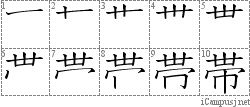
Exceptions: When strokes cross, vertical stroke precede horizontal one.
例外的なもので、縦画を書いた後、横画を後に書く。
田(rice field)
(草書では、十の部分を〆(|━)のように書くので、縦棒、横棒の順で書く。)


王(king)


曲(songs)

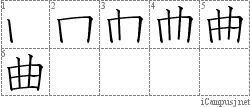
馬(horse)

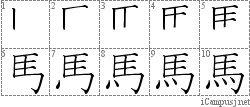
鳥(bird)

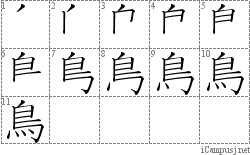
4th
Center first, then left and right
中と左右があって、中・左・右の順に書くもの。
小(small)


業(industry)

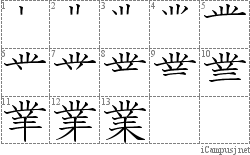
Exceptions: Left first, then center and right
例外として、左・右・中の順に書くもの。
火(fire)


性(gender)

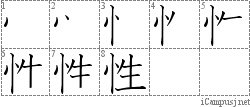
5th
Outer frame first, but bottom line last
囲む形を持つものは、外側が先、ただし、底の線は最後。
四(4, four)


国(country)

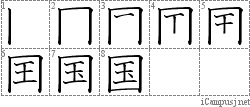
同(same)

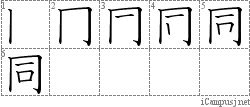
司(director)


Exceptions
囲みを考慮に入れないもの。
区(distinct)


医(medical)

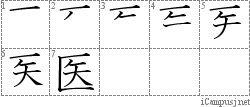
6th
Left sweep first
左払いを先に書く。
人(person)


入(enter)


父(father)


文(sentence)


食(eat)

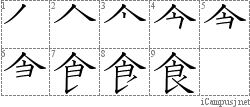
Exceptions
Right sweep first
右払いを先に書く。
力(power)


刀(sword)


万(ten thousand)


方(direction)


別(separate)

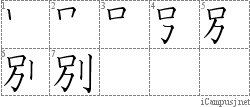
7th
A vertical line running through the center is written last.
貫く縦画は最後に書く
中(center)


干(dry,parch)


平(flat)


Exceptions: A vertical line does not run through the center, then not last.
縦画であっても、つきぬけない縦画は、上部分・縦画・下部分の順で書く。
里(village)

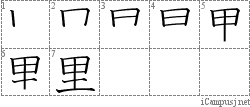
重(heavy)

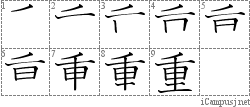
8th
A horizontal stroke that goes through the entire kanji is written last.
横画が全体を貫くときは、横画を最後に書く。
女(woman)


母(mother)


Exception: only one
例外 一字のみ
世(world)


9th
Sweeper stroke first, if a horizontal stroke is longer.
横画が長いものは左払いを先に書く。
短い方が「手のひら」、長い方が「腕」を表しており、安定感を出すために、必ず短い方のから書く。
右(right)


有(exist)

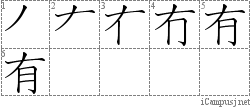
Horizontal stroke first, if a sweeper stroke is longer.
左払いが長いものは横画を先に書く。
短い方が「手のひら」、長い方が「腕」を表しており、安定感を出すために、必ず短い方のから書く。
左(left)


友(friend)


10th
Others
その他
止(stop)


上(up)


耳(ear)

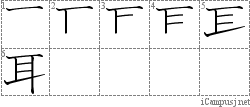
必(must)


発(departure)(左右対称的)

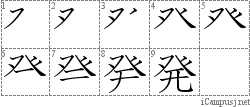
起(wake up)(先に書く「そうにょう」)

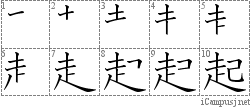
近(near)(後に書く「しんにょう」)


九(9, nine)(先に書く「左払い」、右回り空筆があると考えると分かりやすい)


万(10,000)(後に書く「左払い」、右回り空筆があると考えると分かりやすい)


Kanji Strokes
金(gold)


子(nine)


九(nine)


水(water)


糸(circle, yen)

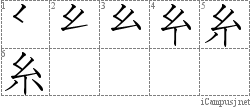
円(circle, yen)


出(exit)


雨(rain)


耳(ear)



Radical on the Left Side of the Kanji/へん(偏)
Radical on the Right Side of the Kanji/つくり(旁)

Radicals on the top/かんむり(冠)
Radicals on the bottom/あし(足)

Radicals which enclose the kanji/かまえ(構)
Radical which Wrap around the bottom of a character/にょう

3 strokes: 「一」-「|」(hook)-(null stroke)-「ン」(1st rule)
持

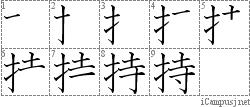
3 strokes: 「フ」-「フ」-「|」, thin B (1st rule)
「陸」、
「院」、
「隆」

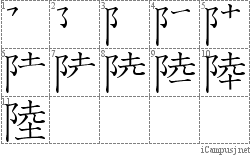
3 strokes: 「、」-「フフ」-「ヘ」(1st rule)
「近」、
「週」、
「道」


3 strokes: 「フ」-「フ」-「ヘ」(1st rule)
「建」


しんにょう,
しんにょうの点(1点, 2点)
内閣告示第一号(昭和五十六年十月一日)
(付) 字体についての解説(以下引用)
常用漢字表では,個々の漢字の字体を,明朝体活字のうちの一種を例に用いて示した。
現在,一般に使用されている各種の明朝体活字には,同じ字でありながら,微細なところで形の相違の見られるものがある。
しかし,それらの相違は,字体の上からは全く問題にする必要のないものである。
常用漢字表では,個々の漢字の字体を,明朝体活字のうちの一種を例に用いて示した。
字体としては同じであつても,明朝体活字の形と筆写の楷書の形との間には,いろいろな点で違いがある。それらは,印刷上と手書き上のそれぞれの習慣の相違に基づく表現の差と見るべきものである。
衣、
去、
玄
衣

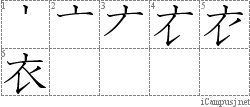
去


玄


人、
家、
北
人


家


北


入、
八、
芝、
史
入


八


芝


史


子、
手、
了
子


手


了


心
雨、
戸、
無
雨


戸


無

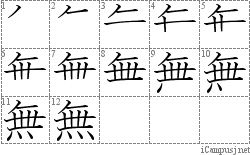
風、
日、
仰、
庄、
主、
言、
年
風

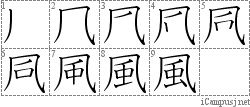
日


仰

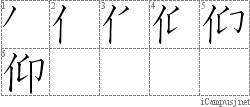
庄

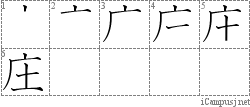
主


言

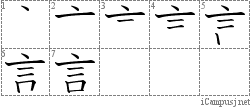
年


又、
文、
月、
条、
保
又


文


月


条

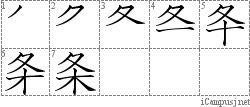
保

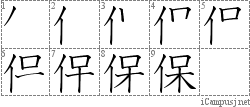
奥、
公、
角、
骨
奥

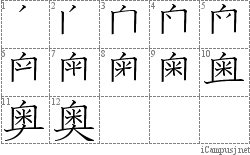
公


角

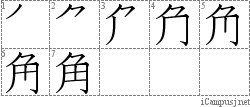
骨

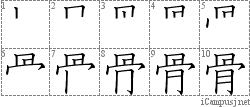
切、
改、
酒、
陸、
穴、
木、
来、
糸、
環
切


改

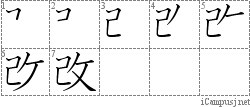
酒

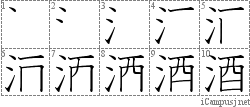
陸


穴


木


来


糸


環
令、
外、
女
令


外


女


電子黒板に漢字の筆順アニメーションを表示し、空書き学習の電子教材として利用できます。

